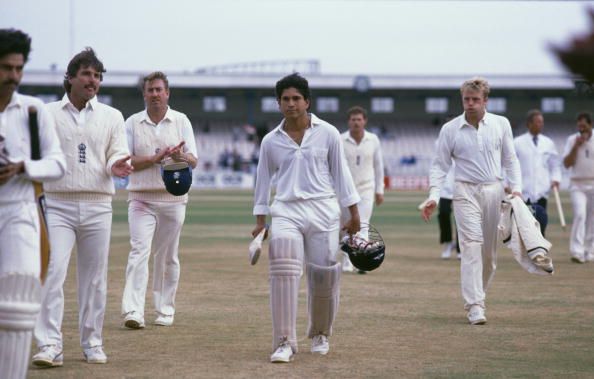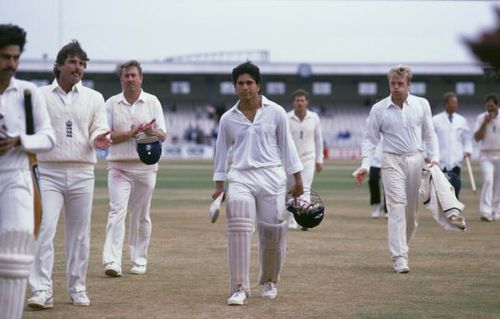
25 years of Sachin Tendulkar: How the little master united India as a nation

Roll back the clock by 25 years, the future of the world's largest democracy, the world's most electric yet precariously gargantuan nation was in tatters. In 1989, we were a nation in stark poverty, overly protectionist and thus largely backward. On the economic front, there was absolute skepticism about opening up the doors, while on the sociological front, the nation was rife with religious carnages. If this wasn't enough, the Mandal commission's affirmative action had incited several caste groups to clash, thus threatening the very pluralistic idea of this nation.
Hence, the concept of India – a nation that has a national holiday for Eid, Christmas, Guru Nanak Jayanthi, a nation that had a Muslim President inducting a Sikh Prime Minister, who was given way by a Catholic woman, a Roman and a nation with 80% Hindu population – was under siege. The sense of brotherhood stems from belongingness drawn from a unifying force called democracy, which unfortunately till then had belied our secular discourse.
However, at the turn of the decade, there came breaking the glass ceiling a prodigy, a curly haired, cheeky young imp. For a quarter of a century from then on, we would grow at a hemorrhaging rate, averaging at 8, with the world beating a path to our door step. In less than two decades since 1989, the Muslims and Hindus would embark upon a joint prayer at a mosque, praying for India's victory over Pakistan in the 2011 World Cup semi-final fixture in what can be construed as the most heart warming sight for the fathers of this vastly paradoxical nation. How this diminutive shy toddler – with his self-styled buccaneering swagger – would forge this unity, thus facilitating the conflicting groups to find a common cause is what forms the body of this write up.
Last year when Tendulkar retired, he had left the country in a paroxysm of mourning. A common occurrence for two decades now, all the nation spoke of was about the impending departure of the master from the nation’s de facto national sport. The media were quick to catch on this fever, and there were endless paeans for the master, thus neglecting every other potential headline. This prompted an angry article from an activist who accused the media of neglecting other news of national importance and debating endlessly over the "banal inevitability of a sportsman retiring from his game when the going was good". Further, interesting was a reaction to this article by someone who'd grown in rural Bihar with vivid memories of the unifying force Tendulkar was.
He watched TV, certainly a luxury for that strata of the society, on tractor batteries only to get a sight of the master wielding the willow, and he'd witnessed the entire village – Bumihars, Brahmins and Dalits alike – cheering this young lad. He didn't mince words when he said the nation needs more Tendulkars to dissolve the boundaries between the North and the South, Hindus and Muslims, the upper castes and Dalits. The internet, often replete with pseudo seculars and an overwhelmingly vociferous saffron brigade, all of a sudden looked truly secular. It was a manifestation of how nationalism had permeated to the grass-roots levels of the country notwithstanding the stress and strain that besets it. Hence, Tendulkar's success was emblematic of his countrymen's rise to assertion.
For many years before 1989, India was used to sporting mediocrity. It was appalling how such a populous nation faired so dismally Olympic after Olympic. India was in a serious dearth of sporting heroes, and sporting success was something the nation hitherto hadn't tasted. Conquests were something Indians had heard only in history and fables, and majority of the times they were in the receiving end. Hence, when the tables were turned and in reality when some Indian was taking it out against the cricket powerhouses, it was nothing short of gratifying for another Indian, now watching this unwind in his television. Thanks to liberalization, televisions were now a household item and so was Tendulkar. However, what led to what isn't clear.
India did possess some of the best batting talents in Sunil Gavaskar and Gundappa Viswanath, but Tendulkar's game was on a whole new level, with a never seen before aggression. The authority and confidence his shots exuded was so uncharacteristic of an Indian sportsman till then. For an average Indian, watching Tendulkar bat was more like watching a commercial potboiler, with the hero battering and whipping every goon who came his way. After all, we are a nation who made chief ministers out of these commercial heroes and hence concomitant with it was the enormous veneration.
A farmer cheated by the monsoon, a low wage worker crippled by unemployment, a daily hawker arm twisted by the local landlord, the middle class confronted with rising prices alike found common cause when they cheered for Tendulkar. He was the solace after a long day's work, the respite in the times of adversities and the reason for the smile in 1.2 billion Indians. As he danced down the track and hoisted Shane Warne out of the park at Sharjah, there ceased to exist Mohammedans, Hindus or Christians; there existed an Indian, who rooted unanimously for his fellow Indian. The eardrum ripping chants of "Sachin Sachin" across the globe was one in unison, a blend of people of different faith chanting one mantra, for one God. No Hindu ever boasted of Tendulkar belonging to his faith nor did any Muslim despise Tendulkar for he hadn't circumcised. Tendulkar was as much a son to a Muslim father, as much a brother to a Dalit as much a hero he was to a Hindu.